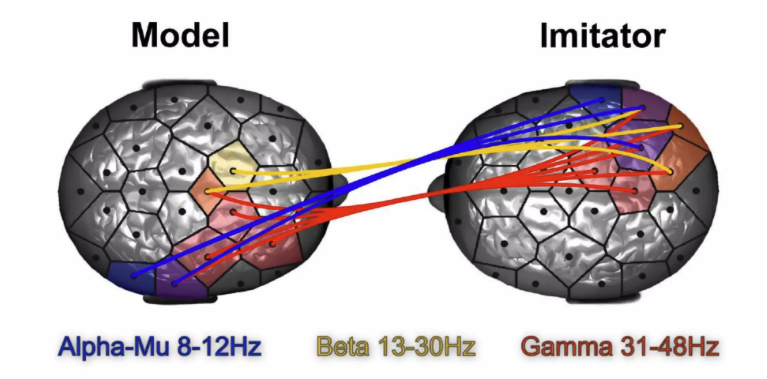Definition
Research on interbrain synchronisation, also known as ‘hyperscanning’, investigates how the brain activities of several people are synchronised during social interactions. Pioneering work by Montague et al. (2002) introduced the method of simultaneous fMRI scanning of two interacting individuals [1]. Since then, studies such as that of Dumas et al. (2010) have shown that synchronisation of brain activity between individuals occurs during social interactions, particularly in regions associated with social cognition and mirror neurons [2].
Discussion
Recent research has investigated the role of interbrain synchronisation in different social contexts. For example, Dikker et al. (2017) found increased synchronisation of brain activity between students during lessons, which correlated with increased engagement and learning success [3]. Mu et al. (2018) showed that interbrain synchronisation increases during collaborative tasks and is related to the quality of collaboration [4]. These studies suggest that diencephalic synchronisation may be a neural correlate of successful social interaction and communication.
Research on interbrain synchronisation also raises questions about the nature of consciousness and social cognition. Hasson et al. (2012) argue that synchronisation between brains could serve as a mechanism for the creation of a shared social reality [5]. This perspective opens up new possibilities for understanding phenomena such as collective consciousness or shared intentionality. At the same time, methodological and conceptual challenges arise, as Konvalinka and Roepstorff (2012) point out, especially with regard to the interpretation of causality and the functional significance of the observed synchronisation patterns [6].

References:
[1] Montague, P. R., Berns, G. S., Cohen, J. D., McClure, S. M., Pagnoni, G., Dhamala, M., … & Fisher, R. E. (2002). Hyperscanning: simultaneous fMRI during linked social interactions. Neuroimage, 16(4), 1159-1164.
[2] Dumas, G., Nadel, J., Soussignan, R., Martinerie, J., & Garnero, L. (2010). Inter-brain synchronization during social interaction. PloS one, 5(8), e12166.
[3] Dikker, S., Wan, L., Davidesco, I., Kaggen, L., Oostrik, M., McClintock, J., … & Poeppel, D. (2017). Brain-to-brain synchrony tracks real-world dynamic group interactions in the classroom. Current Biology, 27(9), 1375-1380.
[4] Mu, Y., Guo, C., & Han, S. (2018). Oxytocin enhances inter-brain synchrony during social coordination in male adults. Social cognitive and affective neuroscience, 13(10), 1082-1093.
[5] Hasson, U., Ghazanfar, A. A., Galantucci, B., Garrod, S., & Keysers, C. (2012). Brain-to-brain coupling: a mechanism for creating and sharing a social world. Trends in cognitive sciences, 16(2), 114-121.
[6] Konvalinka, I., & Roepstorff, A. (2012). The two-brain approach: how can mutually interacting brains teach us something about social interaction?. Frontiers in human neuroscience, 6, 215.